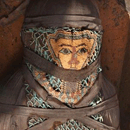Archaeologists Uncover Bead-Covered Mummy
Associated Press
March 1, 2005
SAQQARA, Egypt - Archaeologists uncovered three coffins and a remarkably well-preserved mummy in a 2,500-year old tomb discovered by accident - after opening a secret door hidden behind a statue in a separate burial chamber, Egypt's chief archaeologist said Wednesday.
The Australian team was exploring a much older tomb - dating back 4,200 years - belonging to a man believed to have been a tutor to the 6th Dynasty King Pepi II, when they moved a pair of statues and discovered the door, said Zahi Hawass, Egypt's top antiquities official.
Inside, they found a tomb from the 26th Dynasty with three intricate coffins, each with a mummy.
"Inside one coffin was maybe one of the best mummies ever preserved," Hawass told reporters at the excavation site in the cemetery of Saqqara, a barren hillside pocked with ancient graves about 15 miles south of Cairo.
"The chest of the mummy is covered with beads. Most of the mummies of this period - about 500 B.C. - the beads are completely gone, but this mummy has them all," he said, standing over one of the mummies that was swathed in turquoise blue beads and bound in strips of black linen.
The names of the mummies have not been determined, but the tomb is thought to be that of a middle-class official.
Hawass said the wooden coffins, called anthropoids because they were in the shape of human beings, bore inscriptions dating to the 26th Dynasty, together with a statue of a deity called Petah Sakar. Petah was the god of artisans, Hawass said, while Sakar was the god of the cemetery.
The door was hidden behind 4,200-year-old statues of a man believed to have been Meri, the tutor of Pepi II, and Meri's wife, whose name was not revealed.
Meri also was believed to oversee four sacred boats found in the pyramids, which were buried with Egypt's kings to help them in the afterlife, Hawass said.
"I believe this discovery can enrich us about two important periods in our history, the Old Kingdom, which dates back to 4,200 years, and the 26th Dynasty, that was 2,500 years ago," Hawass said.
According to tradition, Pepi II - the last ruler of the 6th Dynasty - ruled from 2278-2184 B.C., one of the longest reigns in ancient Egyptian history.
Naguib Kanawati, the head of the Australian team from Sydney's Macquarie University, said the site had fallen into neglect after Pepi II's rule and was covered by 50 feet of sand, until it was used again as a cemetery 2,600 years later.
"By that time the art of mummification was perfected to the extreme," Kanawati said.
Archaeologists would begin tests on the mummies to learn more about their medical conditions, including using CT scans, as they were presently doing on King Tutankhamun, Hawass said. The results of Tut's scans will be revealed next week, he said.





 Share your thoughts in the Forum
Share your thoughts in the Forum